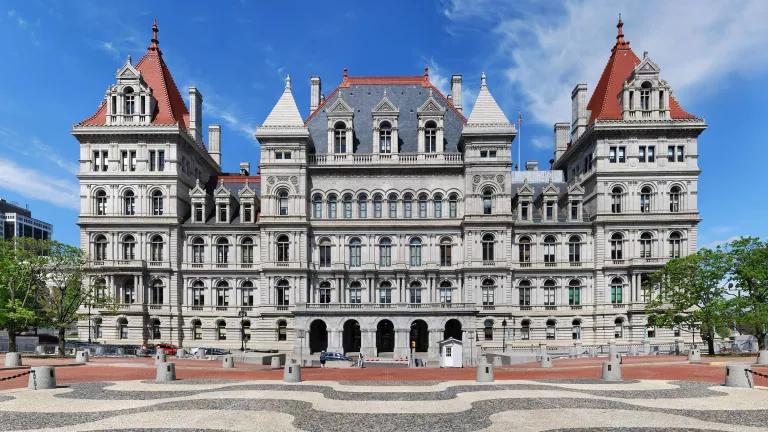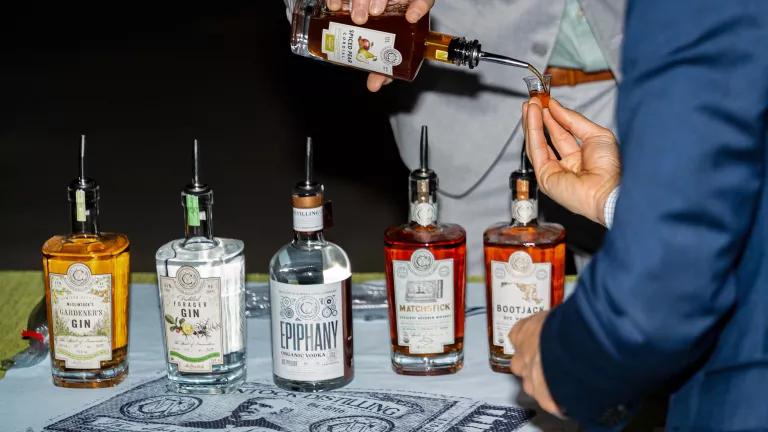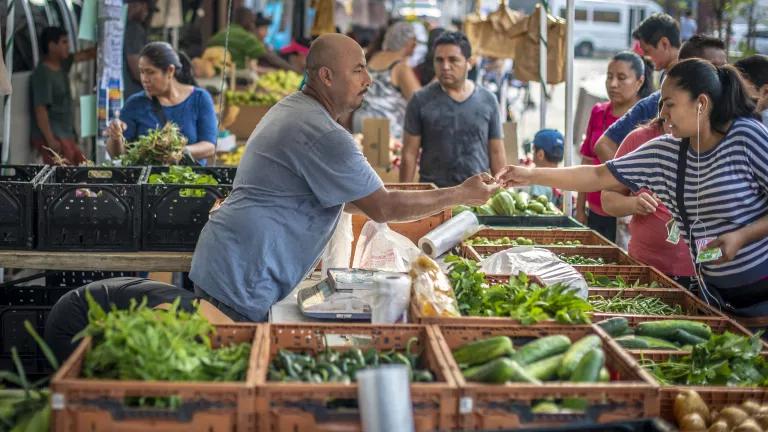Governor Hochul’s Opportunity to Help New York Farmers
Nation-leading bill pending before the Governor would boost municipal purchasing of local, healthier, and more sustainably produced food.

Mark Izeman/NRDC
A first-of-its-kind state bill that could help transform the way cities and towns across New York buy their enormous quantities of food passed the Legislature in Albany in the final days of its 2024 regular session last month. The bill now awaits the signature of Governor Hochul, who must take action on the bill before the end of the year.
The legislation, known as the “Good Food NY Bill,” seeks to address some key problems of our current food system – including environmental and climate damage, an epidemic of food-related disease, labor violations, and racial and other inequities in how we produce, distribute and consume food.
The bill also rightly aims to boost municipal purchasing of food from local farms, which often struggle to survive economically.
In a year where few environmental-related bills have advanced, passage of this bill through the Legislature is a significant win.
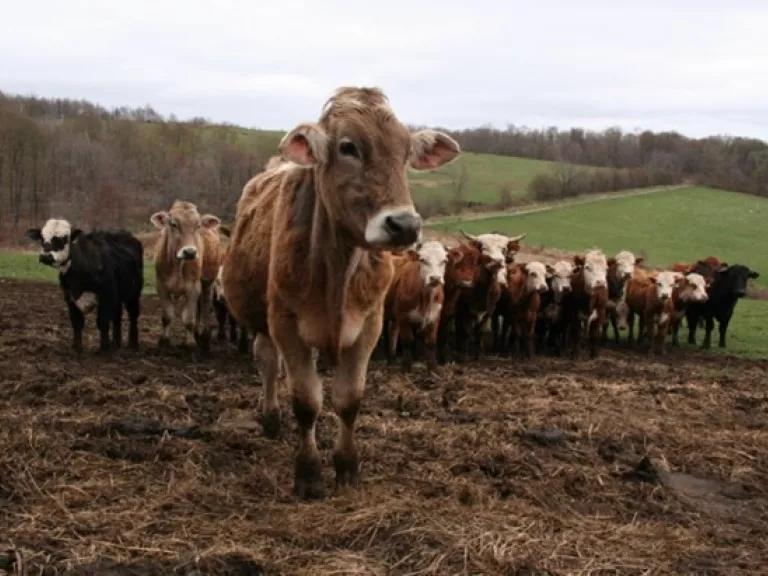
The Good Food NY bill would help often struggling New York farms.
Mark Izeman/NRDC
Lowest Bidder and Best Value Purchasing
A New York State law, originally passed in 1953, sets forth the basic framework that municipalities and political subdivisions must follow when they buy food for schools, hospitals, senior centers and other public institutions. This law – Section 103 of the state’s General Municipal Law - imposes strict requirements on how cities and towns can solicit and award contracts for food (and other goods and services) largely to prevent corruption, favoritism and the overspending of public monies. Historically, the law required, in most circumstances, that municipalities award public contracts to the “lowest responsible bidder.”
However, in 2012, General Municipal Law Section 103 was amended by the Legislature to alternatively allow cities and towns, in certain circumstances, to award contracts that advance “best value” – in essence, a combination of cost, quality, and efficiency. Previously, this best value purchasing process was only authorized for state agencies. At that time, the Legislature stated in an official memorandum of support that allowing cities and towns to use the best value option – still based on largely economic-related factors - “is critical to efforts to use strategic sourcing principles to modernize the supply chain and ensure that taxpayers obtain the highest quality goods and services at the lowest potential cost, while also ensuring fairness to all competitors.”
Both the “lowest responsible bidder” and “best value” procurement methods are aimed at ensuring the responsible use of public funds by cities and towns. But neither option provides municipalities sufficient flexibility to fully consider factors that are critical to their own local constituencies: whether it supports local farms, the nutritional quality of the food and impact on public health, equity, what impact its production has on our environment, how workers and animals are treated, and other criteria that impact our region and planet.
The Good Food NY Bill
Enter the Good Food NY Bill (S.6955A /A.7264A). At its core, this legislation would amend General Municipal Law Section 103 to allow municipalities and other political subdivisions to award food purchases that cost up to 10% higher than the lowest bid where “an otherwise qualified bidder” meets “one or more” of seven “values based procurement standards”: (1) local economies; (2) environmental sustainability; (3) racial equity; (4) valued workforce; (5) valued agricultural sector; (6) animal welfare; and (7) nutrition.
Additionally, the bill requires greater transparency on how food vendors meet these values, including submitting “relevant supply chain data” on the suppliers, distributors, processors and producers involved with the municipal food contracts.
Passage of this bill through the New York State Senate and Assembly reflects over three years of work by a 70+ group coalition led by Community Food Advocates and the Good Food Buffalo Coalition that encompasses environmental, animal, public health, labor and local farm advocates. The prime sponsors were Crystal Peoples-Stokes, the Majority Leader of the Assembly, and Michelle Hinchey, a NYS State Senator who chairs the Committee on Agriculture. If enacted, the bill would make New York State a national leader in the movement for values-based good food purchasing. It will also build on New York City’s Good Food Purchasing initiative, which aims to align its whopping $300+ million annual spending on food and meals with similar values to those contained in the new state bill.
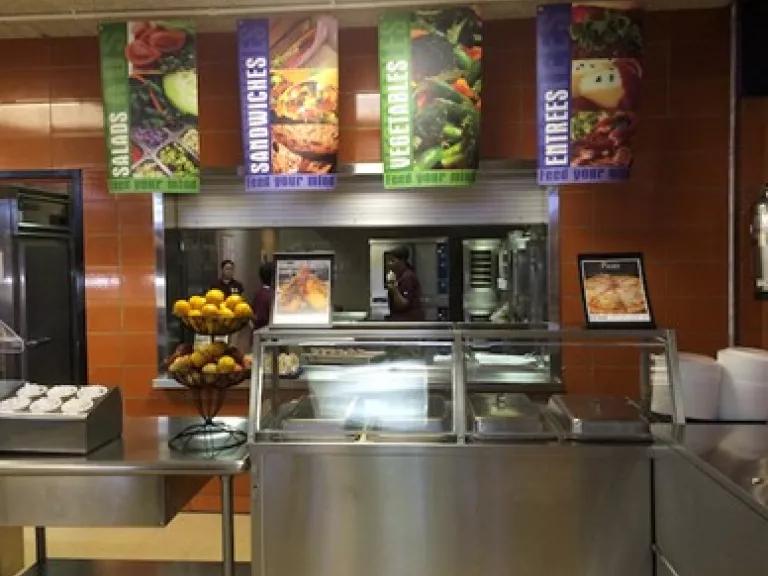
New York City spends more than $300 million each year on food -- including serving roughly 800,000 public school meals each day.
Mark Izeman/NRDC
This new bill is about carrots, not sticks –it would not impose any mandates on cities and towns. Instead, it would simply allow localities to use the so-called “price-preference” when buying food should they choose. And by centering their purchasing decisions on key values like sustainability and health, government agencies can bring about immediate benefits to those being served institutional food and shift the overall marketplace toward better food systems.
This is one reason the Food and Agriculture arm of the United Nations has stated that public procurement of sustainable food is “a key game changer for food systems transformation,” because it can impact “both food consumption and food production patterns” as well as “deliver multiple social, economic, and environmental benefits towards sustainable food systems for healthy diets.”
Maximizing the Bill’s Support of Local and Sustainable Food
The bill now heads to Governor’s Hochul’s desk, weeks or months down the line, for her signature. If the Governor’s Office seeks to enter into discussions with the Legislature over so-called “chapter amendments,” it may open up an important opportunity to amplify the impact of the legislation. One of several key changes to the bill the Governor’s Office could request is to expand the procurement options cities and towns can utilize to buy local and sustainably produced food.
How? Recall that the Good Food NY Bill reforms the current “lowest responsible bidder” procurement mechanism -- the first option under Section 103 of General Municipal Law -- to allow municipalities to pay food vendors up to 10% more than the lowest bidder if the food meets some of the new criteria– local, sustainability, nutrition, animal welfare, etc.
But as currently drafted, the bill does not clearly extend this new price preference to he second primary procurement option under state General Municipal Law – namely, the more sophisticated “best value” process.
This gap leaves a lot on the table because the “best value” procurement process is especially important to New York City and other large municipal buyers around the state. Indeed, New York City alone is one of the largest food buyers in the state and nation – for example, the NYC public schools serve roughly 800,000 meals per day– and the city is increasingly using the best value method in its procurements.
Just last month, New York City directed all mayoral agencies to use, with some exceptions, the “best value” method of procurement for all contracts for goods as well as standard and professional services. Among other objectives, moving all mayoral agency procurement processes to best value allows the City to maximize contracting opportunists for small “Minority and Women Owned Business Enterprises (M/WBE).” Existing New York State procurement law explicitly supports this objective by allowing both state and municipal agencies to give extra weight to proposals from M/WBE vendors through their “best value” procurement decisions.
So, the bottom line is extending the Good Food NY Bill’s seven articulated purchasing criteria to cover not only (a) the “lowest responsible bidder” option, but also (b) the “best value” process in Section 103 of General Municipal Law would dramatically increase opportunities for cities and towns to support local and sustainably managed farming operations – as well as M/WBE vendors – through their procurement processes. Of course, cities and towns do not always have the extra money to apply a 10% price preference to their food contracts. But again, since the Good Food NY Bill simply provides municipalities the option of using the price preference, there are only upsides to broadening any final bill language to incorporate the powerful “best value” purchasing tool that the State Legislature added to General Municipal Law in 2012.
Ensuring a thriving agricultural sector in New York – home to more than 33,000 farms – is critical to the state’s economy and providing greater access to high-quality, local food. Promoting sustainably produced food is good for our environment, our communities, and our health. The Good Food NY bill marries these two objectives by reforming the state’s outdated municipal procurement laws and unlocking hundreds of millions of dollars of new purchasing power. And that seems like a great recipe for good (food) policy.

